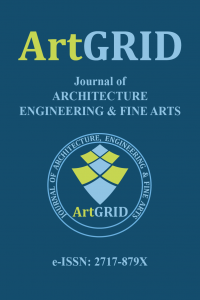İRAN'DA SÜRDÜRÜLEBİLİR MİMARİ YAKLAŞIMLI KONUT BİNALARININ SICAK VE KURAK ALANLARDA İNCELENMESİ
Mimarinin ve yapının iç tasarımının biçim ve mekânının oluşumunda önemli ve etkili faktörlerden biri de kullanıcılarının kültürüdür. Konut alanında, kullanıcıların mekânla olan bağlantılarının miktarı diğer kullanımlara göre çok daha fazla olduğu gibi, konut mekânı kullanıcılarının da sahiplik duygusu ve hareket özgürlüğü diğer mekanlara göre daha fazla olduğundan, konut mekânının önemi ve rolü daha fazladır. konut alanlarına sahip olma ve geliştirme kültürü iki katına çıkacaktır. Bu çalışmanın amacı, sıcak ve kuru iklimlerde geleneksel İran konutlarının iç mimarisine kültürünü ve etkisini analiz etmek ve açıklamaktır. Bu makalenin araştırma yöntemi analitik-tanımlayıcıdır.
Anahtar Kelimeler:
Kültür, Iç mimari, Sıcak ve kuru iklim, Konut
INVESTIGATION OF IRANIAN RESIDENTIAL BUILDINGS WITH SUSTAINABLE ARCHITECTURE IN HOT AND DRY AREAS
The culture and knowledge of the residents and users of the building is one of the most important and influential factors in the formation of the form and space of architecture and its interior design. Since the degree of attachment of users and residents to the space and environment in residential buildings is much more than other uses, and also because the sense of ownership and freedom of action of residential building users is higher than other buildings and spaces, so the importance and role of culture in design and the development of residential spaces will be doubled. The aim of this study is to analyze and explain the aspects of culture and its influence on the interior design of traditional Iranian dwellings in hot and dry climates. The research method of this article is analytical-descriptive.
Keywords:
Culture, interior architecture, hot and dry climate, housing,
___
- Admin. (2020, january,13). Media members visit the Orsi house. Retrieved from https://www.orosihotel.com
- Bloughi, M., Yousefi Tazakor, M.(2017). A study of Orusi on Islamic and traditional architecture of Iran and its use in contemporary architecture, International Conference on Contemporary Contemporary Islamic-Iranian Architectural Traditions, Ardebil.
- Çiğan, Ali. Yamaçlı, Ruşen, (2020). “Doğal Enerji, Sürdürülebilir Kalkınma ve Mimarlık Politikaları”. Düzce Üniversitesi Bilim ve Teknoloji Dergisi, Sayı (8) ,554-571.
- Ercoşkun Yalçıner, Ö. (2016). Geleneksel Türk Kentinden Sürdürülebilirlik Çıkarımları, Volum 7, No (19), 522 - 549, 31.05.2016
- Erfani, A., Parvandi, H., Heidari, R. (2016). Investigation of residential buildings with sustainable architecture approach in hot and dry areas, Papers of Third National Conference on Sustainable Development Strategies in Iranian Architecture and Urban Science,Tehran.w
- Heidari, M., Sufi, M., Kameli, M. (2012). Sustainable construction in connection with the indigenous architecture of hot and dry climate, the first national conference on sustainable construction, Mashhad, https://civilica.com/doc/213538
- Kasmaei, M. (2005). Climate and Architecture, Khak Publishing, Tehran
- Laleh. Davarpanah. (2020, July, 25). Iranian Hashti. Chidaneh editorial. From https://www.orosihotel.com
- Mclennan. Jason. (2004). The Philosophy Of Sustainable Design. Kansas City, USA: Ecotone publishing.
- Nasiri, N. (2007). Sustaniable Features of the vernacular architecture: A Case Study of Climatic Controls in the Hot-Arid regions of the Middle Eastern and North African Regions
- Oral, K. G., Manioglu, G., (2005). Climate Balanced Design: Mardin, Antakya, TASARIM, 157, 136-142, Ankara.
- Pirnia, M. K., Memarian, Gh., (2009). Stylistics of Iranian architecture, Sourush Danesh Publishing, Tehran.
- Pirnia, M. K., Memarian, Gh., (2013). Iranian Islamic Architecture, Sourush Danesh Publishing, Tehran.
- Sajjadi Ghaem Maghami, P, Purdihimi, Sh, Zarghami, I. (2011). Principles of social sustainability in residential complexes from the perspective of the Iranian community of experts and specialists, Volume 20 - Numbers 3 and 4 Scientific-Research (Ministry of Science), 75-88.
- Sajjadzadeh, Hossein, Karkhaneh, Vahid, Makfi, Nilufer. (2015).” Sıcak ve Kuru İklimlerde Sürdürülebilir Mimari Modellerinin İncelenmesi Örnek Olay:
- Kashan Kasabası Evleri”. Sürdürülebilir Kalkınma Yaklaşımıyla İnşaat Mühendisliği ve Mimarlık Ulusal Dergisi, Sayı 2(1) 797-799.
- Soflaei, F. (2004), Sustainability of Climatic Elements in Traditional Iranian Architecture, Proceedings of the Third International Conference on Fuel Efficiency in Buildings, Tehran
- Tahabaz, M. (2018)ç Principles of a Desert Architecture, Safa Magazine, No. 32
- Tatar, Elif, (2013). “Sürdürülebilir Mimarlık Kapsamında Çalışma Mekanlarında Gün Işığı Kullanımı İçin Bir Öneri”. Süleyman Demirel Üniversitesi Fen Bilimleri Enstitüsü Dergisi, 17(1), 147-162,
- Thomas, R. (2009), M.A., Mag. Arch., LEED AP, Architect, and Niklas SpitzMonterey Peninsula College INTD62, Spring 2009” The Principles of Green Building Design” Spring 2009
- Watson, D., Labs, K., (2014). Ghobadian, V., Feiz Mahdavi., Translation. Basım ve Yayın Enstitüsü, Tahran Üniversitesi
- URL 1. www.inspiredcitizen.com/where-to-stay-in-fes-morocco-riad-maison-bleue/ Date of access 06, January, 2022
- URL 2. www.alamy.com/stock-photo/ouarzazate-morocco-street.html Date of access 06, January, 2022
- URL 3. www.tripinmorocco.com/hollywood-africa-ouarzazate-city Date of access 10, January, 2022
- URL 4. www.vaziri-semnani.ir Date of access 09, Febuary, 2022
- URL 5. www.orosihotel.com Date of access 09, Febuary, 2022
- Yayın Aralığı: Yılda 2 Sayı
- Başlangıç: 2019
- Yayıncı: Hakan OĞUZ
Sayıdaki Diğer Makaleler
ORMAN EKOSİSTEMLERİNDE KARBON DİNAMİĞİNİN TEMEL BİLEŞENLERİ VE PLANLAMADAKİ YERİ
İRAN'DA SÜRDÜRÜLEBİLİR MİMARİ YAKLAŞIMLI KONUT BİNALARININ SICAK VE KURAK ALANLARDA İNCELENMESİ
Esra ACAR, Merve DAĞ, Rüya ARDIÇOĞLU
Gülşen AKIN GÜLER, Aslı ÖZÇEVİK BİLEN
GLİSEROL İLE STABİLİZE EDİLMİŞ TOPRAK KAPLAMALARIN NEM DİRENCİ
